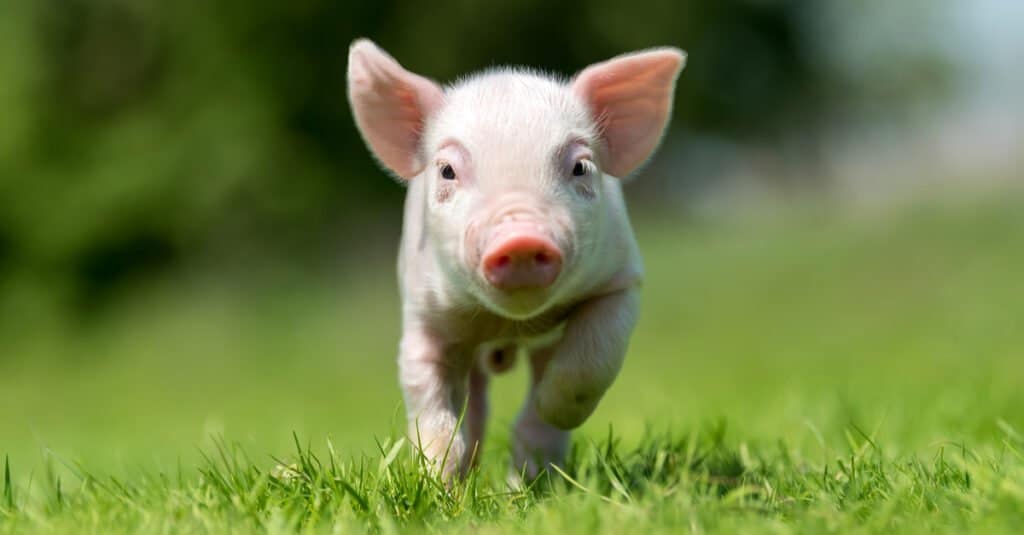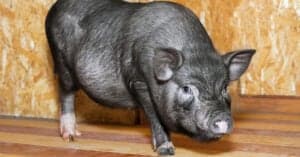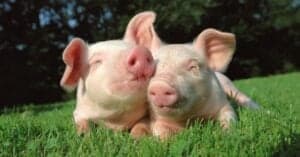Pig Teeth: Everything You Need to Know
Pigs, also called swine or hogs, will famously eat anything. They’re hyper intelligent for livestock, and spend their lives focused on one thing; food. Domestic pigs are even toed, omnivorous, ungulate members of the Suidae family. They have long, almost prehensile snouts that they use to root and dig around for good things to eat.
But with such a focus on food, just what kind of teeth do pigs have? Here, we’ll answer that question, and many more. We’ll explore pig teeth all the way from birth to old age, and analyze each tooth type in detail. Then, we’ll go over the proper care of pet pig teeth, and how pigs’ teeth have changed through domestication.
Piglet Teeth

Volodymyr Burdiak/Shutterstock.com
Piglets are born with some of their baby teeth already erupted and ready to go. These are called ‘needle’ teeth, and include the incisors at the front of the mouth. Because piglets often use these teeth to hurt other piglets (competition over the mother’s teats is fierce), farmers often clip them soon after birth.
As they grow, the piglets gradually get more teeth, until they have a full complement of 28 baby teeth; 12 incisors, 4 canines, and 12 premolars. When they’re young, they only drink milk, so they don’t have much use for all those teeth. But as they get bigger, they wean off milk, and gradually eat more and more solid food.
Diphyodonts
Pigs, like many mammals, are diphyodonts. This means that they don’t have just one set of teeth for life; but two, like humans. The adult teeth begin erupting at around four months old, starting with the molars. The rest of the permanent teeth (incisors, canines, and premolars) don’t push out the baby teeth until about eight months. By the time they’re a year old, pigs have all of their adult teeth.
How Many Teeth Does a Pig Have?
Pigs are omnivores and need as many tooth types as they can get. They mostly eat vegetables and fruits, but will eat pretty much anything they come across that seems edible. With 44 teeth, they’re capable of eating everything from grass, to acorns, to carrion.
Incisors

Viktoria Stolyarova/Shutterstock.com
Pigs have 12 incisors (six on the top and six on the bottom) that jut forward from their mouths. The first two pairs of incisors are forward and close together, while the third pair is further back, closer to the canine tooth. There is a small gap between the second and third incisor, and between the third incisor and the canine.
Canines
Pigs have four canines, sometimes called tusks. These are large and sharp. In boars, they continue growing throughout life, and can even curve back into the skull if misaligned. They’re meant to help the pig manage larger meals, and fend off other pigs and predators. Males in particular may use their tusks to establish dominance.
Premolars
In the upper jaw, all the premolars are close together. Pigs have 16 premolars altogether; eight on the top, eight on the bottom, and eight on each side. There is a large gap called a diastema between the upper canine and the first premolar. In the bottom jaw, the first premolar is very small, and is located right behind the canine. The other three bottom premolars are farther back, located just in front of the molars.
Molars
The biggest chewing teeth in the pig’s mouth are the molars. Pigs have 12 molars altogether; six on top, six on bottom, and six to a side. Both the premolars and molars are known as brachydont teeth, meaning they have low crowns (ridges). These teeth are used to grind up the variety of foods in the pigs’ diet. They have irregular chewing surfaces that occlude (grind) against each other to masticate food.
Pet Pig Teeth

Dusan Petkovic/Shutterstock.com
Pet pigs have become popular pets in recent decades; they’re cute, intelligent, and have long lifespans. But just because they’re pets doesn’t mean that they lose their normal dentition. Even the tiny pot-bellied pig comes equipped with canines. If these tusks don’t grind against each other the way they’re supposed to, they can become overgrown.
Overgrown tusks can present a few problems to both pig and owner. First, they hamper the pig’s ability to eat properly. Second, they can become dangerous, both to other pigs or pets, and to the owner. And third, pigs with large tusks tend to ‘grind their teeth’, which can quickly become extremely annoying.
Owners of pet pigs should take care to ensure that they feed their pig an appropriate diet. If they suspect that their pet porker may have overgrown tusks, they should take them to a specialist vet for trimming. It’s important not to attempt to trim your pig’s teeth yourself, as this could lead to breakage, fracture, and even infection in the tooth root.
Domestic Pig Teeth Vs. Wild Pig Teeth
Pigs are very similar to their wild cousins, boars. They were initially domesticated by people over 10,000 years ago. Archaeologists can tell exactly when wild pigs became livestock by looking at their teeth. The teeth of wild pigs are significantly larger than those of domestic pigs. As successive generations of pigs lived in captivity, their teeth got smaller, and became a hallmark of the domestic pig.
Today’s domestic pigs don’t have much differentiating them from wild pigs. In fact, if a pig escapes and goes feral, its tusks will soon grow larger. If that pig has feral offspring, those offspring will also have larger teeth than they would if they were still living in captivity. All that tooth flexibility demonstrates just how adaptable pigs are.
More from A-Z Animals
Pigs, also called swine or hogs, will famously eat anything. They’re hyper intelligent for livestock, and spend their lives focused on one thing; food. Domestic pigs are even toed, omnivorous, ungulate members of the Suidae family. They have long, almost prehensile snouts that they use to root and dig around for good things to eat.
But with such a focus on food, just what kind of teeth do pigs have? Here, we’ll answer that question, and many more. We’ll explore pig teeth all the way from birth to old age, and analyze each tooth type in detail. Then, we’ll go over the proper care of pet pig teeth, and how pigs’ teeth have changed through domestication.
Piglet Teeth

Volodymyr Burdiak/Shutterstock.com
Piglets are born with some of their baby teeth already erupted and ready to go. These are called ‘needle’ teeth, and include the incisors at the front of the mouth. Because piglets often use these teeth to hurt other piglets (competition over the mother’s teats is fierce), farmers often clip them soon after birth.
As they grow, the piglets gradually get more teeth, until they have a full complement of 28 baby teeth; 12 incisors, 4 canines, and 12 premolars. When they’re young, they only drink milk, so they don’t have much use for all those teeth. But as they get bigger, they wean off milk, and gradually eat more and more solid food.
Diphyodonts
Pigs, like many mammals, are diphyodonts. This means that they don’t have just one set of teeth for life; but two, like humans. The adult teeth begin erupting at around four months old, starting with the molars. The rest of the permanent teeth (incisors, canines, and premolars) don’t push out the baby teeth until about eight months. By the time they’re a year old, pigs have all of their adult teeth.
How Many Teeth Does a Pig Have?
Pigs are omnivores and need as many tooth types as they can get. They mostly eat vegetables and fruits, but will eat pretty much anything they come across that seems edible. With 44 teeth, they’re capable of eating everything from grass, to acorns, to carrion.
Incisors

Viktoria Stolyarova/Shutterstock.com
Pigs have 12 incisors (six on the top and six on the bottom) that jut forward from their mouths. The first two pairs of incisors are forward and close together, while the third pair is further back, closer to the canine tooth. There is a small gap between the second and third incisor, and between the third incisor and the canine.
Canines
Pigs have four canines, sometimes called tusks. These are large and sharp. In boars, they continue growing throughout life, and can even curve back into the skull if misaligned. They’re meant to help the pig manage larger meals, and fend off other pigs and predators. Males in particular may use their tusks to establish dominance.
Premolars
In the upper jaw, all the premolars are close together. Pigs have 16 premolars altogether; eight on the top, eight on the bottom, and eight on each side. There is a large gap called a diastema between the upper canine and the first premolar. In the bottom jaw, the first premolar is very small, and is located right behind the canine. The other three bottom premolars are farther back, located just in front of the molars.
Molars
The biggest chewing teeth in the pig’s mouth are the molars. Pigs have 12 molars altogether; six on top, six on bottom, and six to a side. Both the premolars and molars are known as brachydont teeth, meaning they have low crowns (ridges). These teeth are used to grind up the variety of foods in the pigs’ diet. They have irregular chewing surfaces that occlude (grind) against each other to masticate food.
Pet Pig Teeth

Dusan Petkovic/Shutterstock.com
Pet pigs have become popular pets in recent decades; they’re cute, intelligent, and have long lifespans. But just because they’re pets doesn’t mean that they lose their normal dentition. Even the tiny pot-bellied pig comes equipped with canines. If these tusks don’t grind against each other the way they’re supposed to, they can become overgrown.
Overgrown tusks can present a few problems to both pig and owner. First, they hamper the pig’s ability to eat properly. Second, they can become dangerous, both to other pigs or pets, and to the owner. And third, pigs with large tusks tend to ‘grind their teeth’, which can quickly become extremely annoying.
Owners of pet pigs should take care to ensure that they feed their pig an appropriate diet. If they suspect that their pet porker may have overgrown tusks, they should take them to a specialist vet for trimming. It’s important not to attempt to trim your pig’s teeth yourself, as this could lead to breakage, fracture, and even infection in the tooth root.
Domestic Pig Teeth Vs. Wild Pig Teeth
Pigs are very similar to their wild cousins, boars. They were initially domesticated by people over 10,000 years ago. Archaeologists can tell exactly when wild pigs became livestock by looking at their teeth. The teeth of wild pigs are significantly larger than those of domestic pigs. As successive generations of pigs lived in captivity, their teeth got smaller, and became a hallmark of the domestic pig.
Today’s domestic pigs don’t have much differentiating them from wild pigs. In fact, if a pig escapes and goes feral, its tusks will soon grow larger. If that pig has feral offspring, those offspring will also have larger teeth than they would if they were still living in captivity. All that tooth flexibility demonstrates just how adaptable pigs are.






